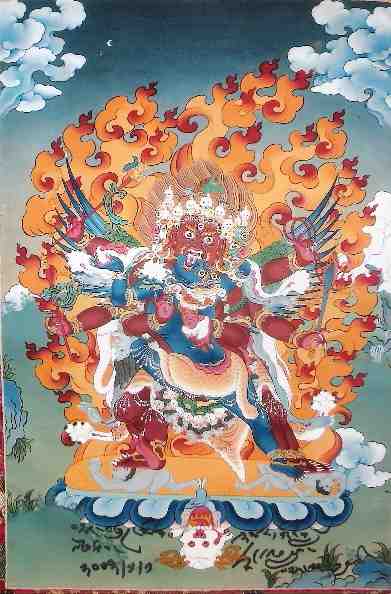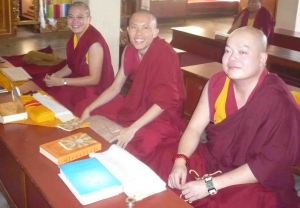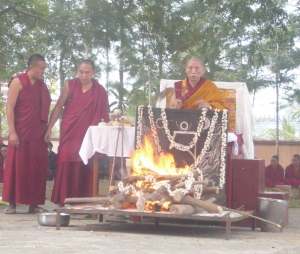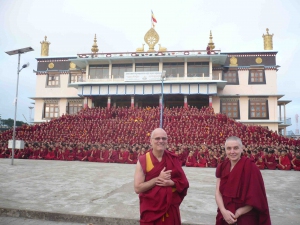Life at Sera Je Monastery, South India
Ven. Sera Je
Last year I was fortunate to be amongst a handful of non-Sera IMI monks and nuns who were permitted to join the annual Hayagriva retreat at Sera Je, South India, along with all the lamas, geshes and monks.
Sera Je is the mother monastery of our founding lamas, Lama Yeshe and Lama Zopa Rinpoche, along with many of their great teachers, such as Geshe Rabten Rinpoche, Geshe Sopa Rinpoche, Choden Rinpoche, Geshe Senge Rinpoche, Gomo Tulku and some of our outstanding senior FPMT lamas and geshes, such as Pari Rinpoche, Yangsi Rinpoche, Khensur Rinpoche Jampa Tekchok, Geshe Lama Konchog, Khen Rinpoche Lama Lhundrup, Geshe Jampa Gyatso, Geshe Tashi Tsering, Geshe Tsulga, Geshe Dakpa, and Geshe Doga, to say nothing of the precious younger geshes that are following their example—in fact most of our resident geshes and lamas come from Sera Je.
 Hayagriva is a wrathful aspect of the Buddha of Compassion Chenrezig with a close connection to the Dalai Lamas. It has a particular emphasis on controlling—bringing together all those conditions needed for successful practice—and dispelling obstacles. The lineage of the practice of Hayagriva comes from Buddha Amitabha and was introduced to Tibet by the great Indian master Padmasambhava, who was invited to Tibet by King Trisong Detsen to dispel the obstacles to the Dharma taking root in Tibet. Hayagriva practice actually stems from the Nyingma tradition—why then such a close connection with this great Gelug seat of learning, Sera Je?
Hayagriva is a wrathful aspect of the Buddha of Compassion Chenrezig with a close connection to the Dalai Lamas. It has a particular emphasis on controlling—bringing together all those conditions needed for successful practice—and dispelling obstacles. The lineage of the practice of Hayagriva comes from Buddha Amitabha and was introduced to Tibet by the great Indian master Padmasambhava, who was invited to Tibet by King Trisong Detsen to dispel the obstacles to the Dharma taking root in Tibet. Hayagriva practice actually stems from the Nyingma tradition—why then such a close connection with this great Gelug seat of learning, Sera Je?
Founding of Sera Je Monastery
Well, the founder of Sera Je, Kunkhen Lodroe Rinchen Senge, was a disciple of Lama Tsong Khapa born into a Nyingma family. He was a highly realized being who received all the teachings and initiations of Hayagriva from his father, Tokden Yonten Gonpo. He became a monk, entering Drepung Monastery, later becoming a learned Geshe with 100 students. But because of his devotion to the Hayagrava practice there was lot of talk at the monastery (and some criticism).
So he left Drepung with his 100 students and then went to Sera Monastery. At the time, there were already four Sera Dratsung (Upper Sera, Lower Sera, Gya Dratsung and Domting Dratsung). As they approached Sera Monastery, the conch was being blown to call the monks to assembly. So he and his students joined the monks in the assembly hall. When he went to make offering to the statues, one statue of an arhat talked to him, welcoming him to Sera. They then joined the Sera monks in prayers and tea (mangja). At this time he thought it would be good to join Sera Monastery.
He then toured around around Sera to investigate where he might build a temple and settle with the monks. While investigating he came to the place where it is said that he saw Hayagriva in the form of a red bird absorb into a berry bush (where Sera Je monastery would be built). Later a statue of Hayagriva was built and the thorn bush put inside. It still exists at Sera Je, outside Lhasa, having survived the Cultural Revolution and it is regarded as one of the most precious holy objects in Tibet, with healing powers. The phurba given Kunkhen Lodroe Rinchen Senge by his father, also still exists in Tibet and on occasions is ceremoniously displayed to crowds who come for blessings. In this way Hayagriva became a very special protector deity for Sera Je, and it said that the reason the Sera monks are so good at Madhyamaka philosophy and why so many great scholars emerged is due to the blessing of the karmic connection with this deity.
Hayagriva Empowerment with HH Dalai Lama at Sera Je Monastery
Actually, the previous year I had been in South India while the monks were doing the annual Hayagriva retreat. His Holiness Dalai Lama had just given the Hayagriva empowerment at Sera Je Temple and following that special Hayagriva pujas were being performed in the Hayagriva shrine sponsored by FPMT. At that time Lama Zopa Rinpoche was receiving lungs from Khyongla Rinpoche at Osel Labrang along with several other high lamas and monks. I had wanted to join in the retreat but was told it was not possible because only Sera Je monks could participate. Hayagriva practice is particularly praised and recommended by His Holiness as the most effective practice for the liberation of Tibet, so each year there is a retreat at Sera and millions of mantra are recited for the long life of His Holiness and for Tibet. As I stood outside the temple, uplifted by the chanting and collective energy of 3,500 monks praying for these precious causes, I was inspired to circumambulate and try to merge my prayers with theirs. At the end of the retreat, Rinpoche was invited to the main temple to perform fire pujas and give a talk to all the monks. He thanked them for the retreat; telling them it was so important for His Holiness and for Tibet.
The Retreat with Sera Je Monks
 My enthusiasm having been roused in this way, I took the opportunity last year with the support of Ven. Monlam, our IMI director, Ven. Dechen, and Venerables Yeshe Gyatso and Gyurme to request the Gegu of Sera Je if we could join the retreat. Gen Ngawang Sangye of Osel Labrang, our constant help and support at Sera, put forward the request and the Gegu agreed. We were allowed to sit in the special Hayagriva shrine where the statues and mandala are housed, which was perhaps the most blessed seating arrangement we could have since we were literally staring at Hayagriva and entourage all day! It also allowed us more freedom with the discipline (not having to sit through long talks in Tibetan to the monks that were tacked on to the end of sessions). We were also given permission to partake of the Sera Je food, this is the food offered by Rinpoche to the Sera Je monks only, and it gave us the opportunity to experience first hand the kindness of our Guru. (The chapati is HUGE, the dhal (lentil soup) delicious, and every day a banana!)
My enthusiasm having been roused in this way, I took the opportunity last year with the support of Ven. Monlam, our IMI director, Ven. Dechen, and Venerables Yeshe Gyatso and Gyurme to request the Gegu of Sera Je if we could join the retreat. Gen Ngawang Sangye of Osel Labrang, our constant help and support at Sera, put forward the request and the Gegu agreed. We were allowed to sit in the special Hayagriva shrine where the statues and mandala are housed, which was perhaps the most blessed seating arrangement we could have since we were literally staring at Hayagriva and entourage all day! It also allowed us more freedom with the discipline (not having to sit through long talks in Tibetan to the monks that were tacked on to the end of sessions). We were also given permission to partake of the Sera Je food, this is the food offered by Rinpoche to the Sera Je monks only, and it gave us the opportunity to experience first hand the kindness of our Guru. (The chapati is HUGE, the dhal (lentil soup) delicious, and every day a banana!)
 The retreat lasted 10 days, followed by a fire puja performed by the Abbot in the presence of all the monks and a concluding self-initiation and tsog. There were the usual four sessions a day and in the evenings tea offering and more extensive prayers. Ven. Monlam and myself being the only participants unable to read Tibetan used a sadhana of Mongolian origin translated by Rinpoche. The others followed the chanting with the Tibetan text. The Sera Je monks generally base their Hayagriva practices on sadhanas composed by the Great Fifth Dalai Lama and a previous incarnation of Pari Rinpoche. Ven. Monlam remarked to me that even not understanding a word of Tibetan, it didn’t take long till he could get a pretty accurate “feel” for where the monks were in the sadhana and keep up with them—so don’t be put off all you who speak non-Tibetan-speakers!
The retreat lasted 10 days, followed by a fire puja performed by the Abbot in the presence of all the monks and a concluding self-initiation and tsog. There were the usual four sessions a day and in the evenings tea offering and more extensive prayers. Ven. Monlam and myself being the only participants unable to read Tibetan used a sadhana of Mongolian origin translated by Rinpoche. The others followed the chanting with the Tibetan text. The Sera Je monks generally base their Hayagriva practices on sadhanas composed by the Great Fifth Dalai Lama and a previous incarnation of Pari Rinpoche. Ven. Monlam remarked to me that even not understanding a word of Tibetan, it didn’t take long till he could get a pretty accurate “feel” for where the monks were in the sadhana and keep up with them—so don’t be put off all you who speak non-Tibetan-speakers!
For those with Hayagriva retreat commitment, doing retreat this way in a group is very supportive. Ven. Gyurme pointed out to me that when you do retreat at Sera Je, there is no doubt that all the rituals are being done correctly! Sera Je has a special Hayagriva committee composed of monks selected by the deity who are thoroughly trained and groomed in all the precise rituals and chanting involved with the practice—which, as I mentioned before, are uncommon to Gelug since they are of Nyingma origin. My own experience was that, despite all the usual retreat obstacles of lack of concentration, restlessness, sleepiness, painful sitting, (and occasionally having to rush to the bathroom!), there was a great sense of gratitude and appreciation just to be there.
Being at Sera Je
Being at Sera is in itself an immense experience, something quite indescribable. Even though I had spent time at Kopan, Namgyal and other monasteries over the years, still nothing quite prepares you for being at one of these great seats of Gelug learning—Sera, Drepung, Ganden. At times, one feels transported back to medieval Tibet—here is a city of ONLY monks, thousands of them, a great sea of red robes from morning to night and the constant vibration of Dharma, pujas, memorizing, debating…in time-honored fashion. Even the cooks, the shopkeepers, the telephone booth and internet café staff, the yoghurt sellers, the taxi drivers, the tailors are monks.
At times one feels like a tourist in Los Angeles sightseeing the Dratsang and Houses of the great lamas and geshes we hear so much about and know so well—like house-spotting in Hollywood!
At times one feels like one is living in a nuclear power station—a human-being-refinery—where all impurities are slowly but surely being extracted and the very purest essence of humanity is being exposed. For those who can endure the rigors and pace of monastic life with a pure motivation there is no doubt that with every debate session, puja and memorization Buddhahood is coming ever closer… Enlightenment here is a guaranteed product, unavoidable when all the outer and inner conditions are perfectly assembled. The outstanding qualities of our Gurus are simply the trademark of Sera Je and the pure teachings of Lama Tsong Khapa. They are not unique and exclusive, they are attainable, and one day—guided and nurtured by these Sera-trained lamas—we too will achieve them.
 Being at Sera is an opportunity to really marvel at what a Geshe is, what unimaginable qualities and endurance it takes to receive the title Lharampa. As Rinpoche often puts it: a Geshe is like someone who knows every single part of an airplane. In this age of sound bites and specialization, can we imagine the vastness and depth of that knowledge—the result of 20-30 years intensive daily study, debate and practice with some of the brightest, sharpest, fittest, most wholesome minds–often complemented by great hardships? Sometimes we might take for granted when we see the human form of a foreign monk at our centre, the training that they have undergone from a tender of age at Sera it is hard to do so. It is a positive and humbling experience that puts into perspective our own efforts. Being at Sera, it is also easier to appreciate the challenges these geshes face when they leaves such a rarified heightened environment to come to our pop cultures, parochial centers and materialistic environments to teach us. And remember, these monks live in a fragile, exile situation. Many have stories to tell of torture and facing death to escape Tibet to be here; many will make the hazardous journey back after their studies to face whatever necessary in the struggle to revitalize and support the Dharma in their still sadly oppressed country.
Being at Sera is an opportunity to really marvel at what a Geshe is, what unimaginable qualities and endurance it takes to receive the title Lharampa. As Rinpoche often puts it: a Geshe is like someone who knows every single part of an airplane. In this age of sound bites and specialization, can we imagine the vastness and depth of that knowledge—the result of 20-30 years intensive daily study, debate and practice with some of the brightest, sharpest, fittest, most wholesome minds–often complemented by great hardships? Sometimes we might take for granted when we see the human form of a foreign monk at our centre, the training that they have undergone from a tender of age at Sera it is hard to do so. It is a positive and humbling experience that puts into perspective our own efforts. Being at Sera, it is also easier to appreciate the challenges these geshes face when they leaves such a rarified heightened environment to come to our pop cultures, parochial centers and materialistic environments to teach us. And remember, these monks live in a fragile, exile situation. Many have stories to tell of torture and facing death to escape Tibet to be here; many will make the hazardous journey back after their studies to face whatever necessary in the struggle to revitalize and support the Dharma in their still sadly oppressed country.
Lama Zopa’s Holy Projects at Sera Je
At Sera, Rinpoche’s holy projects seem to shine with more meaning and they are so practical: the Sera Je Food Fund—nourishing these monks who study from morning to night; the Lama Tsong Khapa Teacher’s Fund—supporting their teachers so they don’t need to go to the West to raise funds; revitalizing Buddhism in Mongolia; translating vital texts; bringing qualified teachers throughout the world to teach and guide us; the Maitreya project and FPMT itself. Sera Je and FPMT are very closely linked and at Sera it is impossible to escape this. At one point during the retreat the Gegu made a long, long speech in Tibetan and money was distributed…it seemed to go on forever. “What was all that about?” I asked a monk afterwards, “Oh,” he said, “the monastery gave money and asked us to pray for Lama Zopa Rinpoche. It was a long praise of his qualities and how important his activity is for Sera…” Nothing unusual. Rinpoche himself has commented that “As the FPMT develops, it naturally benefits the monasteries of Lama Tsong Khapa’s tradition, particularly Sera Je Monastery. It is dependent arising.” And they, in turn, benefit all of us…
It is hard to spend time at Sera and not be deeply impressed by the extensiveness of Rinpoche’s activity in the Tibetan community (and Rinpoche supports not just Sera but a long list of Tibetan monasteries, nunneries, and tantric colleges of various traditions). At the same time, it is hard to spend time at Sera and not feel that all of us, in some way, are benefitting every day from the existence of this great monastery, and those like it, in so many seen and unseen ways. And this benefit spreads through us to others, benefitting many beings.
There is also a small IMI House at Sera with a great selection of books in English, where a dedicated group of Western monks live and study—great sources of inspiration for now and great hopes for the future. The manager, Ven. Namdak, has been particularly kind over the years in coordinating transmissions and teachings that we as Westerners can participate in. IMI House, Kopan House (where the Kopan monks stay) and Osel Labrang (Lama Osel’s House) at Sera are all very supportive of any of Rinpoche’s students who visit the monastery.
A Visit to Sera Je Recommended
I thoroughly recommend any of our Sangha to spend time in Sera, and to join the Hayagriva retreat is a good way to get some feel for the monastic beat. Being at Sera certainly helped to enrich my understanding and appreciation of my teachers, the sangha and Lama Tsong Khapa’s tradition—like a missing piece in the jigsaw of FPMT.
IMI is hoping it will be possible for our sangha to participate in the Hayagriva retreat each year. If you are interested you will need to apply at least 3 months in advance for a Protected Area Permit and reserve a room at one of the Guest Houses (all women must stay outside the monastery boundaries). Sera is a 6-hour drive from Bangalore and a taxi can be booked to pick you up from the airport. While at Sera, it is also possible to visit Gyurme Tantric College at Hunsur, where many of our lamas have trained in the Vajrayana rituals, as well as Tashi Lhunpo (seat in exile of the Panchen lama), the great Nyingma monastery of Namdroling with its huge golden statues (Indians call it the “Golden Temple) and temples of other traditions in the refugee camp.
Finally, I thank all those who helped me during my stay at the monastery and a special thank you to the Hayagriva committee monks who I so greatly admire and appreciate for faithfully preserving the practices of this deity.
